April 2012, 19(2): 107–115
The Journal of China
Universities of Posts and
Telecommunications
www.sciencedirect.com/science/journal/10058885 http://jcupt.xsw.bupt.cn
Simultaneous image classification and annotation based on
probabilistic model
LI Xiao-xu (*), SUN Chao-bo, LU Peng, WANG Xiao-jie, ZHONG Yi-xin
Center for Intelligence Science and Technology, Beijing University of Posts and Telecommunications, Beijing 1000876, China
Abstract
The paper proposes a novel probabilistic generative model for simultaneous image classification and annotation. The
model considers the fact that the category information can provide valuable information for image annotation. Once the
category of an image is ascertained, the scope of annotation words can be narrowed, and the probability of generating
irrelevant annotation words can be reduced. To this end, the idea that annotates images according to class is introduced in
the model. Using variational methods, the approximate inference and parameters estimation algorithms of the model are
derived, and efficient approximations for classifying and annotating new images are also given. The power of our model is
demonstrated on two real world datasets: a 1 600-images LabelMe dataset and a 1 791-images UIUC-Sport dataset. The
experiment results show that the classification performance is on par with several state-of-the-art classification models,
while the annotation performance is better than that of several state-of-the-art annotation models.
Keywords image classification, image annotation, probabilistic model, variational inference
1 Introduction
With the sharp increase in the number of images stored
on the Internet, it has become increasingly important to
organize and index these resources effectively. Therefore,
research on image classification and annotation in
computer vision is essential. Image classification involves
automatically assigning a class label to a digital image; the
label may refer to the objects, events or scenes depicted.
Image annotation refers to annotating an image with text in
the form of captions or keywords that describe pertinent
objects or scenes in the image.
Much work has been done on image classification and
annotation. Existing techniques can be classified to two
classes: generative and discriminative techniques. Among
the generative methods, a family of models based on latent
dirichlet allocation (LDA) [1] has received significant
attention. These models postulate the existence of a small
set of hidden factors that govern the association between
images and categories (i.e., image classification [2–6]) and
Received date: 12-07-2011
Corresponding author: LI Xiao-xu, E-mail: xiaoxulibupt@gmail.com
DOI: 10.1016/S1005-8885(11)60254-9
between images and annotation words (i.e., image
annotation [3,5,7–8]). For image classification, in Ref. [2]
Li et al. provides the LDA-based seed work. In the study,
each category is identified with its own Dirichlet prior,
which is optimized to distinguish between each other. In
Ref. [3], Wang et al. constructs a module that models the
distribution over categories conditioned on the input of image
topics, and plugs the module into the original LDA model;
as a result, the study proposes a model multi-class (MC)
supervised LDA (sLDA) (MC-sLDA). The model has been
reported to have best performance for modeling
categorized images. Regarding image annotation, in Ref.
[7], Blei et al. proposes the LDA-based classical method
known as corr-LDA, which assumes that image and
annotation words share the same latent topic variable and
that annotation words are generated from subsets of
empirical image topics. These assumptions are made so
that the textual modal and image modal correspond. In Ref.
[8], Putthividhya et al. treats annotation as a classification
problem and proposes sLDA-bin, which is based on the
two models sLDA [9] and corr-LDA. In Ref. [10],
Putthividhya et al. captures varying degrees of correlations
�
108 The Journal of China Universities of Posts and Telecommunications 2012
and relaxes the constraint in previous models that the
number of image topics must be the same as the number of
annotation topics.
In Ref. [3], Wang et al. considers the two tasks of image
classification and annotation simultaneously, although they
are still treated independently in many cases. The study
treats category and annotation attached to a given image as
a global description and local description, respectively; see
Fig. 1. And it proposes the model multi-class sLDA with
annotation by combining a supervised topic model and a
probabilistic model for image annotation so that these two
tasks can be done simultaneously. So far, this model has
achieved the best performance on image classification and
annotation.
Class: forest
Annotations: tree trunk, trunk occluded, ground
grass trees, woman walking, umbrella, dog
(a) An example image from forest class in LabelMe in Ref. [11]
Class: highway
Annotations: sky, sign, ground, trees, road, car, van rear,
streetlight, central reservation, car rear
(b) An example image from highway class in LabelMe in Ref. [11]
Class: croquet
Annotations: tree, plant, athlete, mallet, grass, ball,
wicket
(c) An example image from croquet class in UIUC-Sport in Ref. [5]
Class: badminton
Annotations: badminton racket, playing field,
shuttlecock, athlete
(d) An example image from badminton class in UIUC-Sport in
Ref. [5]
Fig. 1 Example images with class labels and annotations
In this work, we build on several previous studies [3,7],
and we also try to achieve image classification and
annotation simultaneously. We draw on the fact that once
the category of an image is ascertained, the scope of
annotation words for the image can be narrowed.
Meanwhile, the probability of generating irrelevant
annotation words can be reduced. As such, we think not
only can these two tasks of image classification and image
annotation can be performed simutaneously, but also they
can be implemented in ways that improve one another.
Based on this intuition, we propose a novel probabilistic
generative model for simultaneous image classification
and annotation. The performance of our model is
demonstrated on two real-word datasets, and the results
show that our model provides a competitive classification
performance with several benchmark classification models,
while it shows a better annotation performance than other
�
Issue 2 LI Xiao-xu, et al. / Simultaneous image classification and annotation based on probabilistic model 109
benchmark annotation models.
The remaining sections of the paper are organized as
follows. The basic notation, terminology and our model
are introduced in Sect. 2. The framework for parameter
estimation using variational inference is given in Sect. 3.
The classification and annotation performance of our
model based on two real-world image datasets is shown in
Sect. 4. Finally, the conclusions of the study are presented
in Section 5.
2 Modeling images, labels and annotations
2.1 Data representation
(
1
)
M
=Vvv
v
,,...,
2
Suppose that there are D images with class labels and
A. We adopt bag-of-word
sV (see Sect. 4 for additional details). An
mv is a unit basis vector of size
annotations in the dataset
representation for images and annotations text. For images,
we extract features from all images, and then we perform
clustering. The centers of the clusters are used to construct
the image vocabulary, and the length of the vocabulary is
denoted as
sV . Each
image word
image is reduced as a collection of M image words, which
is denoted as
. For annotation text, all
annotation words construct the textual vocabulary, the
nw
tV . An annotation word
length of which is denoted as
tV . The annotation text for
is a unit basis vector of size
(
=Www
each image are denoted as
. The class
label is represented as a unit basis vector of size J, which
A
is denoted as
consisting of
represented as
is to find a model that fits the dataset and then to use the
model to predict the class label and annotation text for new
images.
=c
cc
,,...,
1
2
D
image-class-annotation triples is
{
(
)
Vc W
Ad
D
,,1,2,...,
=
dd
d
. Thus, the dataset
. Our task
w
,,...,
2
{
˛
}
}
(
)
)
N
J
c
1
J
)
c
)
=W (
cc
,,...,
1
2
w
(
=c
ww
,,...,
1
2
corr-LDA [7] and the supervised topic model MC-sLDA [3]
can be linked by sharing the latent topic space of the
images, so that the model can perform image classification
and annotation simutaneously. The generative process of
the model can be concluded as follows. First, generate the
image from some latent topics. Then, generate its
annotation terms or class label conditioned on the same
latent topics which generated the image. Observing the
graphical model representation of MCa-sLDA (Fig. 2), we
and
note that class label variables
annotation text variables
are only
Z , and
indirectly connected via latent topic variables
moreover, they are conditionally independent given the
latent topic variables Z . The weak correlation between
annotation words and class labels means that classification
and annotation cannot provide valuable information for
one another, and thus, any generated annotation words may
turn out to be unrelated to the class label in practice. That
is to say, MCa-sLDA can perform both image
classification and annotation simultaneously, however,
performance of the two tasks cannot be improved mutually.
In the next section, we describe a novel association model
that can perform
classification and annotation
simultaneously, and the model can improve annotation
performance by taking advantage of the results of image
classification.
N
Fig. 2 Graphical model representation for MCa-sLDA model
2.3 The proposed annotation-by-class corr-LDA model
2.2 Multi-class sLDA with annotation model
Our model, which we call the annotation-by-class
Before introducing our model, we first review the
multi-class sLDA with annotation (MCa-sLDA) [3] model,
which is the seed work for simultaneous image
classification and annotation based on probabilistic
generative models, and reports the good annotation and
classification performance. A graphical model representation
of MCa-sLDA is depicted in Fig. 2. The design philosophy
behind MCa-sLDA is that the annotation model
corr-LDA (abc-corr-LDA) model, is conditional on the
number of latent topics K. In particular, the generative
process of abc-corr-LDA for an image-class-annotation
triple (,, )VW c
words is given as follows:
with M image words and N annotation
Step 1 Draw a topic proportion
Step 2 For each image word
1) Draw topic assignment
~(
mv ,
m
p
~( )
)pq
a .
dir
{
1,2,...,
˛
q .
z q
m
mult
M
}
:
�
110 The Journal of China Universities of Posts and Telecommunications 2012
2) Draw image word
m
Step 3 Draw class label
v
z
m
p
~(
cz
)
mult
~(,
p .
z
)p
softmax
m
z m , where
z
=
(
1
M
)
M
m
1
=
z is the empirical frequencies of the topics.
m
The formulation of the softmax function is:
p
(
c z
,
)
m
=
(
exp
exp
J
m
T
c
(
T
m
l
z
)
z
l
1
=
(1)
)
}
:
N
n
y
n
.
unif
˛
{
1,2,...,
}
~n
dirp ’, ‘
p b z
multc,
p
softmax
nw ,
n
{
N˛
.
(
Step 4 For each annotation word
1) Draw topic identifier
2) Draw annotation word
In the above formulation, ‘
unifp
)y
’, ‘ multp
’ represent Dirichlet, Softmax, Multinomial and
nypn
~, 1,2,...,
w z
‘
Uniform distribution, respectively. Our model specifies a
joint distribution over latent variables and observation
variables. Let
}
E = VW c
,
(
)
pEHOppp
, then
(
)
,
O = amp b
)
c z μ
{
}
z yq
,
z θ
mm
z π
H =
{
}
{
=
,,
,,
,
(
)
(
)
(
v
,
,
,
m
and
’ and
M
θ α
p
m
1
=
N
(
pyMP
,,
,
nn
n
1
=
)
n
(
w
y
z β c (2)
)
And a graphical representation of the model is depicted
in Fig. 3.
Fig. 3 Graphical model representation for abc-corr-LDA model
In the generative process, Steps 1 and 2 assume that the
image words of each triple arise from a set of topics. An
image-topic is a distribution over the image vocabulary,
and all topics are shared by entire image collection. Each
image has its own proportion of topics
q , which is
randomly drawn from a Dirichlet distribution. The two
steps describe how to generate image parts of a triple.
Step 3 describes the generative process of the class label,
and the class label is drawn from Softmax regression
conditioned on empirical frequencies of the topics of an
image z . In the Softmax, each parameter can be thought
as a template of the corresponding category, and the class
label of the template most similar to an image will be
assigned to the image.
The above three steps introduce the procedures
n
n
,
,
)
(
p
, the part
(
pEH O
generating image words and class label; we now turn to
Step 4 generating annotation words. In the joint
)
yw
z β c
,,
distribution
shows a direct dependence is designed between class label
c and annotation text w. Given a class c, annotation text
will be generated from the corresponding topic of
annotation terms. In particular, the class label c must first
ny is drawn
be chosen, and an identifier of image topic
from some image empirical topic. Finally, an annotation
word
bc z
, yn
The generative process of our model can be summarized
as follows. First generate an image from some latent topics,
and then generate the class label of the image according to
the latent topics. Finally, generate the annotation words of
the image according to the class label and the latent topics
of the image. Comparing with MCa-sLDA, our model
focuses more on modeling the relationship between class
label and annotation so that classification can be used to
improve annotation.
nw are drawn from the class-annotation-topic
.
3 Variational inference and parameter estimation
3.1 Variational inference
The posterior distribution of the latent variables
q
q
)
)
(
-
)
ø
ß
ØøØ
ºßº
)
,ln,ln
=
(3)
conditioned on a
triple image-class-annotation
p H Vc W is intractable to compute. In this study, we
(,,
use a variational inference method in Ref. [12] to
approximate this distribution. We begin by finding the
lower bound of the log probability given a triple:
(
(
LIOEpEHOEqH I
where q is a variational distribution over the latent
variables
represents variational
parameters. In particular, q is defined as the factorized
distribution:
(
(
qHIqqq y
=
where g is a K-dimensional Dirichlet parameter,
a K-dimensional multinomial parameter, and
M-dimensional multinomial parameter.
}
Given a model
}
I = γ φ λ
,
(4)
and a triplet
O = amp b
)
mφ is
nλ is a
z φ
mmn
and
θ γ
{
{
,,
(
)
)
)
(
λ
1
=
1
=
M
,
,
m
N
n
n
E = VW c
,
,
{
}
, we maximize the lower bound with respect
�
Issue 2 LI Xiao-xu, et al. / Simultaneous image classification and annotation based on probabilistic model 111
}
{
,
,
I = gj l , which is
to the variational parameters
equivalent to minimizing the KL-divergence between this
factorized distribution and the true posterior. We use
coordinate ascent, repeatedly optimizing with respect to
each parameter while holding the other parameters fixed.
g , the
To update the posterior Dirichlet parameter
procedure is the same as in Ref. [1]:
ga
=
iimi
M
+ (5)
j
m
1
=
To update the parameter
mφ , we adopt similar
optimization to Ref. [3], and choose the terms including
mφ from L:
K
(
=-+
i
1
=
V
s
p
j
1
=
φ
mmiimij
jygy
)
+
ln
g
L
v
)
(
1
=
K
j
j
j
Ł
Ł
V
t
N
C
j
1
=
lnexpln
Ł
nl
11
==
Ø
E
Œ
qlmimi
º
ł
1
M
K
l
c
w
l
nmnlij
j
ln
b
+
ł
μ φ
T
c m
-
J
l
1
=
(
μ z
T
)
ł
ø
œ
ß
-
j
i
1
=
(
j
)
Maximizing the above equation under the constraint
=
leads to
j
mi
1
K
i
1
=
jp
miivci
m
exp
(
a φ
old
T
m
N
Ł
) 1
ia-
nl
11
==
ł
J
V
t
j
1
=
c
l
w
ln
lby g
nmnlij
j
+
i
(
)
m
+
1
M
-
(6)
where the notation ‘ ’ means ‘is proportional to ’, and
a
=
ifiljli
J
Ł
M
K
jm
1
expexp
M
ŁłŁ
Ł
j
mφ is previous value.
m
ł
ł
1
=
l
1
=
old
f m
„
Note that
The terms, including
Lagrange multiplier are:
1
M
ł
nmλ
, with the approximate
L[]lnln
tV
c
l
l
JK
=-+
ljlbllh
nmminmnlijnmnmnnm
lij
111
===
Setting L[]
nmnml
¶¶
=
tV
K
J
expln
b
Ł
li
11
==
1
=
j
lj
nmminlij
-
j
w
1
l
0
leads to
M
Ł
m
1
=
ł
l
c
j
w
(7)
ł
Updating γ requires φ , updating φ requires λ and
γ , and updating λ requires φ , which naturally leads to
an inference algorithm. Eqs. (5) –(7) are therefore invoked
repeatedly until the lower bound of the log probability in
Eq. (3) converges.
3.2 Parameter estimation
We use variational expectation-maximization (EM)
,
,,
}
{
of
model
algorithm framework to obtain approximate the maximum
likelihood estimation
parameters
O = amp b . During the E-step, we use variational
inference to obtain approximate posterior distributions for
each triple, which simplifies optimization in the M-step.
During the M-step, we maximize the lower bound on the
log probability of the collection A, that is, maximizing
D
(
LALI O
with respect to the model parameters
d
1
=
,,
,
O = amp b . The variational EM algorithm alternates
between these two steps until
(
L A converges.
We isolate the terms, including
ijπ , from
add the appropriate Lagrange multipliers, then
(
L A , and
)
{
}
=
(
)
)
)
;
d
L[]ln
D
M
d
p
=+
pjph
ijdmiiviij
dm
11
==
ßπ
Let L
ø
Ø
=º
¶¶
ijij
dMD
-
1
m
j
V
s
Ł
1
=
π
0
, leads to
ł
p
j
v
j
ijdmidm
d
The terms, including
1
=
1
=
m
lijb , are:
(8)
L[]ln
bjl
d
D
N M
b
lijdndmidnmlij
m
1
11
==
=
=
dn
d
j
c w
l
Maximizing the above equation under the constraint
=
leads to
b
lij
1
tV
j
1
=
d
N M
D
bj l
dn
lijddndmidnm
11
==
1
=
m
d
c w
l
j
(9)
dM
K
=
cddmici
m
1
=
i
1
=
Ł
j
exp
Ł
1
M
d
m
ł
ł
for convenience,
Let
K
then
M
L[]ln
DK
mj m
=
idmicicd
dmi
1
M
111
===
d
d
J
d
1
=
c
-
K
(10)
Taking the derivative with respect to cim yields:
]
m
i
L[
¶
m
ci
DK
1
=-
M
dmi
d
111
===
Ł
dM
J
c
c
j
dmidcd
c
1
=
Ł
K
-
1
ł
M
d
M
K
1
=
cd
m
d
m
1
=
Ł
j
dmici
exp
1
M
Ł
M K
dmd
m
d
ł
łł
(11)
This is not a closed-form solution. Therefore, we adopt
�
112 The Journal of China Universities of Posts and Telecommunications 2012
the conjugate gradient to optimize
cim [13].
3.3 Image classification and annotation
In the previous sections, we introduced our model and
provided a scheme to estimate the model ’s parameters. In
this section, we introduce the procedures used to predict
class label and annotations. In the test sets, the images are
not labeled or annotated. For every image in the test sets,
we first use the LDA [1] inference step to solve for
(
zqg j
q
including l , from Eq. (4), and removing the terms,
including μ , from Eq. (6).
. This is equivalent to removing the terms,
)
,
,
For classification, we classify the images by using the
z . The class
empirical frequencies of the image-topics
label with the maximum probability is assigned to the
given image, which is equivalent to choosing a class label
. Let
which maximizes the expectation of
Tμ z
φ
m
, which results in the following
M
)
=
φ
M
(
1
m
1
=
formulation:
c
*
=
argmaxargmaxqc
Ø
º
E
{
}
cJc
J
1,2,...,1,2,...,
˛
μ z
T
=
ø
ß
{
˛
c
}
μ φ (12)
T
N
For annotation, we use the following formulation:
(
)
wvcw z
pp
,,,
Note that the class label
) (
c is obtained from the
»
q
1 z
=
(13)
β c
(
)
z
n
n
n
n
procedure used to predict classification.
4 Experiments
We test our model on a 1 600-image subset of the
LabelMe dataset from Ref. [11] and a 1 791-image subset
of the UIUC-Sport dataset from Ref. [5]. The LabelMe
data contains eight classes:
‘street’, ‘tall building ’,
‘highway’ ‘open country’, ‘inside city’, ‘“forest’, ‘coast’
and ‘mountain.’ Each class contains 200 images. The
UIUC-Sport data contains eight classes:
‘badminton’,
‘polo’, ‘croquet’, ‘bocce’, ‘rock climbing ’, ‘sailing’,
‘rowing’ and ‘snowboarding’. The number of images in
each class varies from 137 (bocce) to 329 (croquet), and
the total number of the dataset is 1 791.
For the LabelMe data, the preprocessing steps are:
1) Apply grid-sampling technique (the grid size is
5 5· ). Extract a 1616·
centers, and then represent each patch using a
128-dimensional SIFT [14] region descriptor.
patch from each of the grid
2) Run the
k-means algorithm [15] over these
descriptors, and set the number of the centers as 240. Then
all of the centers constitute a codebook of images.
Construct the annotation vocabulary using all of the
different annotation words.
3) Finally, remove the annotation terms that occurred
less than three times for the two data sets, and evenly split
each class to create training and testing sets.
For the UIUC-Sport data, we extract 2 500 patches
uniformly for each image in this dataset. The size of each
patch is 3232·
LableMe data. Note that all testing is on images that are
not labeled or annotated.
. The other steps are same as for the
4.1 Image classification
To assess the classification performance of our model,
we compare it with two state-of-the-art LDA-based models
and two SVMs: MC-sLDA, MCa-sLDA, SVM with
polynomial kernel (SVM-POl) [16], and SVM with radial
basis function kernel (SVM-RBF) [16]. As seen in Fig. 4,
our model shows the best performance for 100 topics, and
average accuracy of the model achieves 77.1% on
LabelMe dataset. It outperforms 0.8% than MCa-sLDA
and 1.5% than MC-sLDA. A similar improvement is
observed for the UIUC-Sport dataset, as shown in Fig. 5.
At the same time, we also perform the popular
classification methods SVM-POl and SVM-RBF, however,
the results are undesirable. The accuracy of SVM-POL is
51.5% on UIUC datasets, and 67.0% on LabelMe dataset.
The accuracy of SVM-RBF is 30.1% on UIUC datasets,
and 36.0% on LabelMe dataset. Because the accuracies of
the two SVMs are low, the results about the two SVMs are
not marked in Figs. 4 and 5. All the results show that our
model provides competitive classification performance.
Fig. 4 Average accuracy compared over all classes based on
five random training and test subsets for the LabelMe dataset
�
Issue 2 LI Xiao-xu, et al. / Simultaneous image classification and annotation based on probabilistic model 113
Fig. 5 Average accuracy compared over all classes based on
five random training and test subsets for the UIUC-Sport
dataset
4.2 Image annotation
To assess the annotation performance of our model, we
compute the F-measure to compare our model with the
three state-of-the-art annotation models: multi-modal LDA
(mm-LDA) [7], corr-LDA [7] and MCa-sLDA [3]. We first
annotate each image in the test set with five words by
computing Eq. (13). We compute the top-N F-measure, and
let
better than the other three approaches. We improve the
F-measure by approximately 6% for the LabelMe dataset
and approximately 9% for the UIUC-Sport dataset.
5N = . As seen in Figs. 6 and 7, our model performs
The main reason for the improvement is that
classification parts and annotation parts in our model are
interactional. The generation of an annotation word
requires that the class label of an image is first determined.
Fig. 7 The F-measure compared over all classes based on
five random training and test subsets of the UIUC-Sport
dataset
Then, an annotation word is chosen from the annotation
topics of that class. So that, the uncertainties and
difficulties associated with choosing annotation text are
reduced.
Figs. 8–10 shows the example results for our model and
MCa-sLDA on the two datasets. It is not difficult to see
that the annotation results of our model are more precise.
For example, MCa-sLDA annotates an image in class
‘coast’ with ‘mountain’ and ‘building’, which obviously do
‘coast’, and it annotates an image in class
not fit with
‘sailing’ with ‘battledore’, which also does not fit with
‘sailing’ (see Fig. 8). Many annotation results of
MCa-sLDA present similar errors. However, our model
helps avoid this kind of error.
Fig. 6 The F-measure compared over all classes based on
five random training and test subsets of the LabelMe dataset
Ground truth (class: coast) person standing, person walking,
sand beach,sky, water sea
Mca-LDA (class: coast) sky, mountain, road, trees, building .
Our model (class: coast) sky, sea water, mountain, sand beach,
rock.
Fig. 8 An example result from coast class in LabelMe
�
114 The Journal of China Universities of Posts and Telecommunications 2012
results also show the appropriateness of our approach.
Based on the proposed model ’s generative process, its
predicting procedure and the experiment results, we
confirm that classification provides valuable information
for annotation, but annotation only has a small effect on
classification. In future work, we plan to study how to
utilize annotation procedures to improve classification
performance so as to iteratively enhance performance of
both classification and annotation processes.
Acknowledgements
This work was supported by the Major Research Plan of the
National Natural Science Foundation of China (90920006).
References
1. Blei D M, Ng A Y, Jordan M I. Latent Dirichlet allocation. Journal of
Machine Learning Research, 2003, 3(4/5): 993-1022
2. Li F F, Perona P. A Bayesian hierarchical model for learning natural scene
categories. Proceedings of the IEEE Conference on Computer Vision and
Pattern Recognition (CVPR’05): Vol 2, Jun 20 -25, 2005, San Diego, CA,
USA. Los Alamitos, CA,USA: IEEE Computer Society, 2005: 524-531
3. Wang C, Blei D M, Li F F. Simultaneous image classification and
annotation. Proceedings of the IEEE Conference on Computer Vision and
Pattern Recognition (CVPR ’09), Jun 20-25, 2009, Miami, FL, USA. Los
Alamitos, CA, USA: IEEE Computer Society, 2009: 1903-1910
4. Cao L L, Li F F. Spatially coherent latent topic model for concurrent
segmentation and classification of object and scenes. Proceedings of the
11th IEEE International Conference on Computer Vision (ICCV ’07), Oct
14-21, 2007, Rio de Janeiro, Brasil. Piscataway, NJ,USA: IEEE, 2007: 8p
5. Li L J, Li F F. What, where and who? Classifying event by scene and object
recognition. Proceedings of the 11th IEEE International Conference on
Computer Vision (ICCV ’07), Oct 14 -21, 2007, Rio de Janeiro, Brasil.
Piscataway, NJ, USA: IEEE, 2007: 8p
6. Quelhas P, Monay F, Odobez J M, et al. Modeling scenes with local
descriptors and latent aspects. Proceedings of the 10th IEEE International
Conference on Computer Vision (ICCV ’05): Vol 1, Oct 17 -21, 2005,
Beijing, China. Piscataway, NJ, USA: IEEE, 2005: 883-890
7. Blei D M, Jordan M I. Modeling annotated data. Proceedings of 26th
International Conference on Research and Development in Information
Retrieval (SIGIR’03), Jul 28 -Aug 1, 2003, Toronto, Canada. New York,
NY, USA: ACM, 2003: 127-134
8. Putthividhya D, Attias H T, Nagarajan S S. Supervised topic model for
automatic image annotation. Proceedings of the 35th IEEE International
Conference on Acoustics, Speech, and Signal Processing (ICASSP’10), Mar
14-19, 2010, Dallas, TX, USA. Piscataway, NJ, USA: IEEE, 2010:
1894-1897
9. Blei D M, McAuliffe J D. Supervised topic models. Proceedings of the 21st
Annual Conference on Neural Information Processing Systems
(NIPS’07), Dec 7-8, 2007, Whistler, Canada. Cambridge, MA, USA: MIT
Press, 2007: 121-128
10. Putthividhya D, Attias H T, Nagarajan S S. Topic regression multi-modal
latent Dirichlet allocation for image annotation. Proceedings of the IEEE
Conference on Computer Vision and Pattern Recognition (CVPR ’10), Jun
13-18, 2010, San Francisco, CA, USA. Los Alamitos, CA, USA: IEEE
Computer Society, 2010: 3408-3415
Ground truth (class: rowing) Athlete, bank, boat, lake, oar, post,
railing, spectator, tree, wall.
Mca-LDA (class: rowing) athlete, sky, tree, water, rowboat.
Our model (class: rowing) athlete, oar , rowboat, water, lake.
Fig. 9 An example result from rowing class in UIUC
Ground truth (class: sailing) athlete, bank, floater, sailing boat,
sky, water.
Mca-LDA (class: sailing) athlete, sky, sailing boat, water,
battledore
Our model (class: sailing) sky, water, athlete, sailing boat,
floater.
Fig. 10 An example result from sailing class in UIUC
5 Conclusions
This paper proposes a novel probabilistic model called
annotation-by-class corr-LDA for simultaneous image
classification and annotation. The approximate inference
and parameter estimation algorithms of the model are
derived, and efficient approximations for classifying and
annotating new images are also given. Based on previous
work, our model introduces the insight that once a
category is assigned to an image, the scope of annotation
can be reduced. As such, the model can reduce the
probability of generating unrelated annotation words, so
that it can improve the annotation performance based on
category information. The performance of the model is
demonstrated on two real-word datasets. The classification
performance is on par with several state-of-the-art
classification models, while the annotation performance is
superior to several state-of-the-art annotation models. The
�
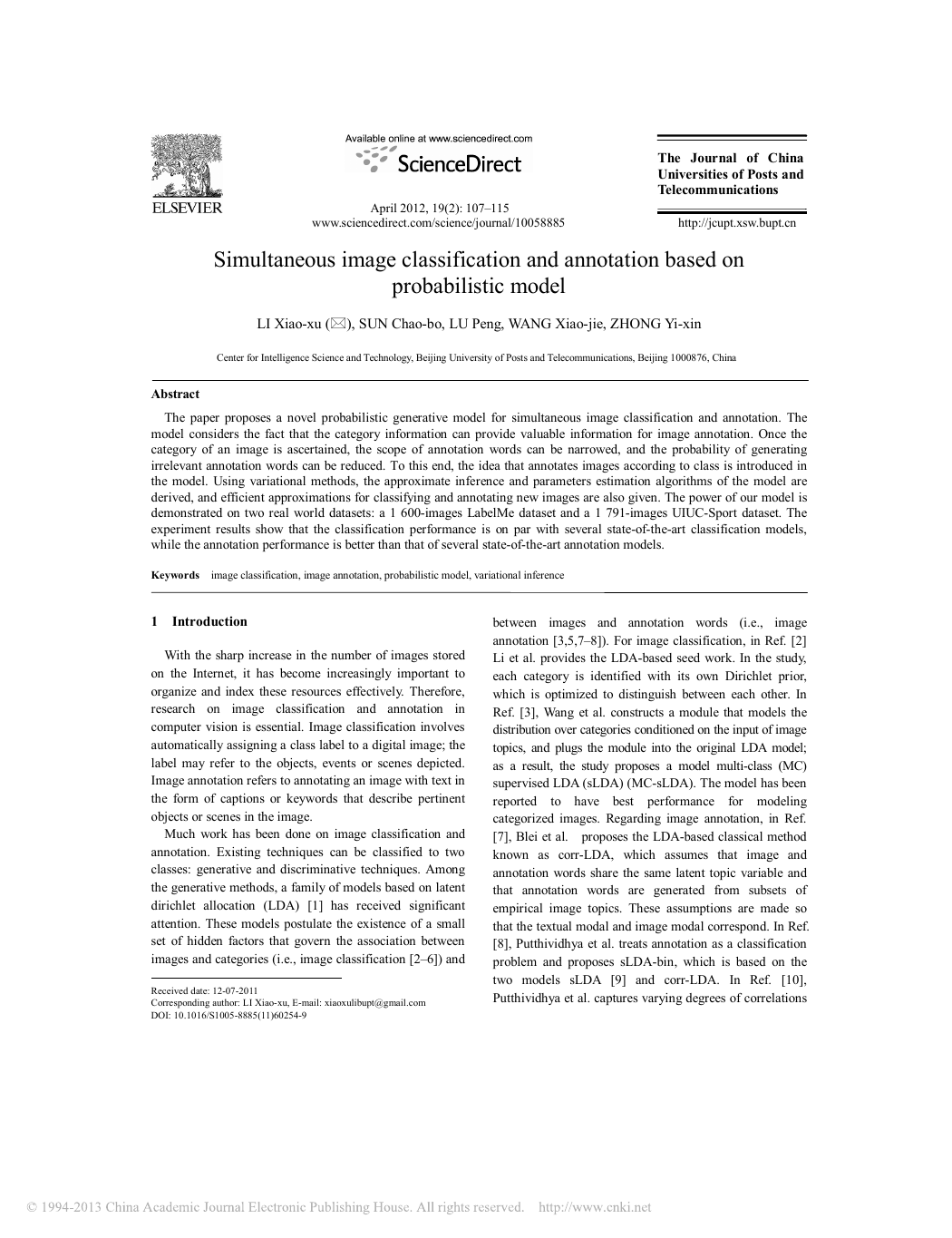
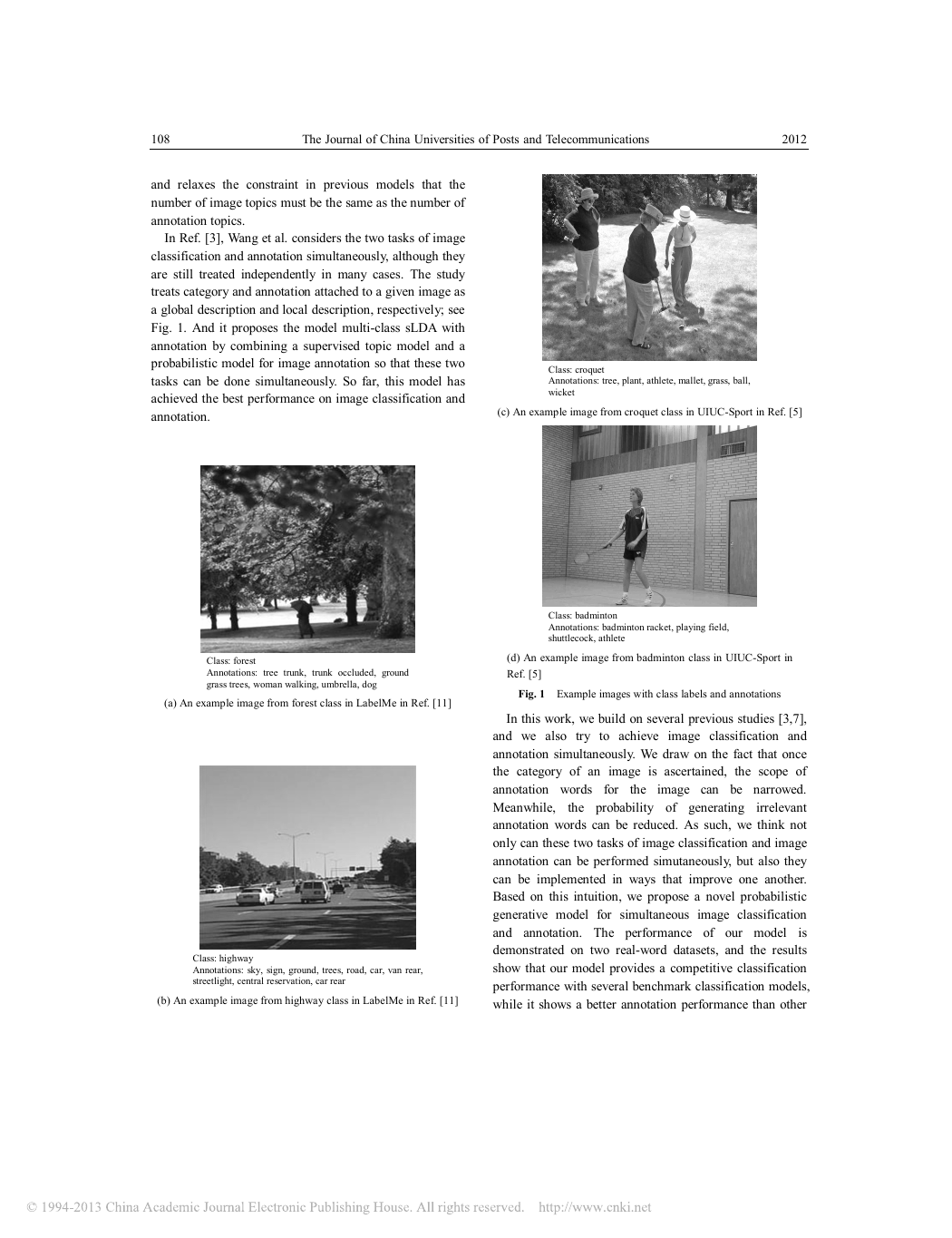
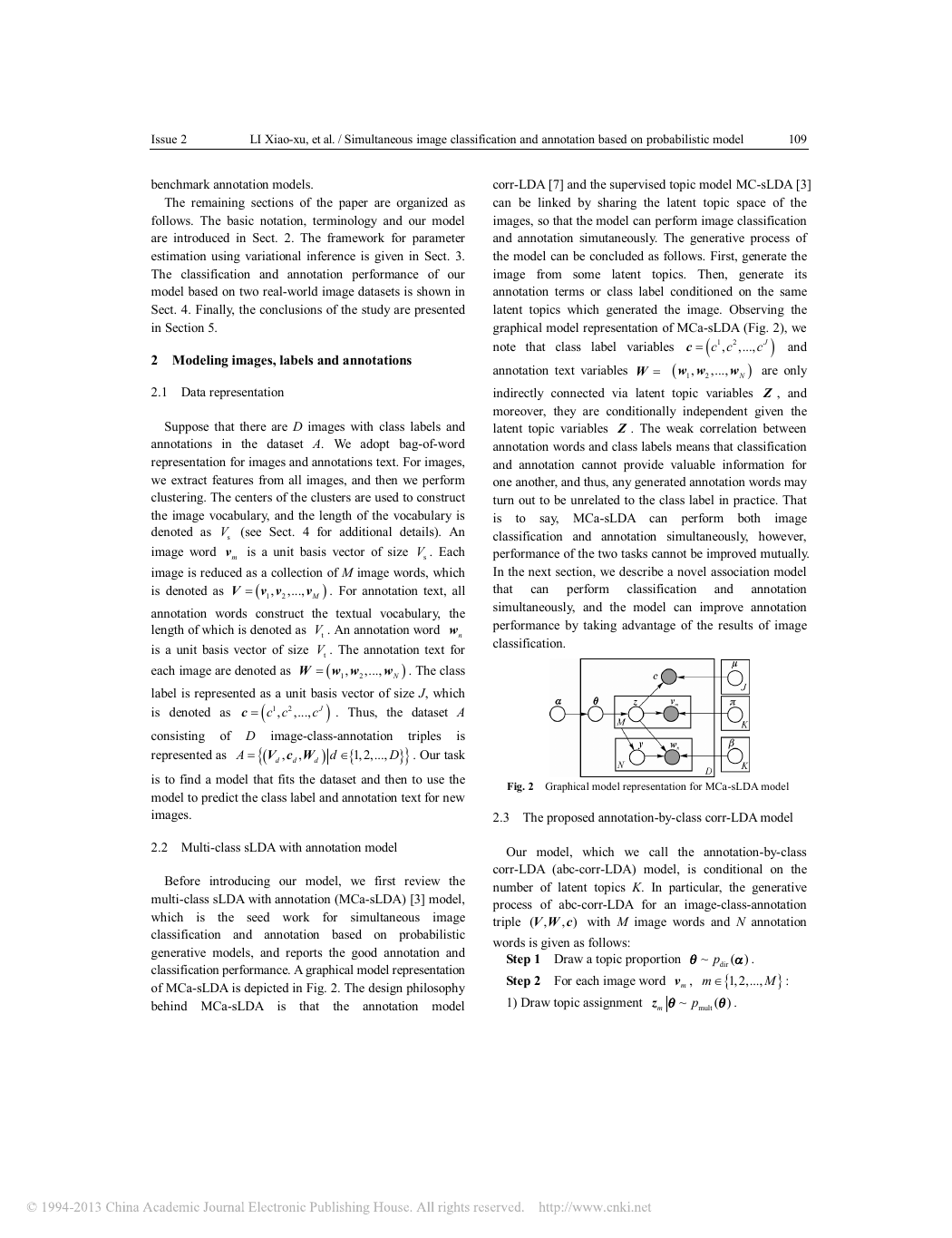
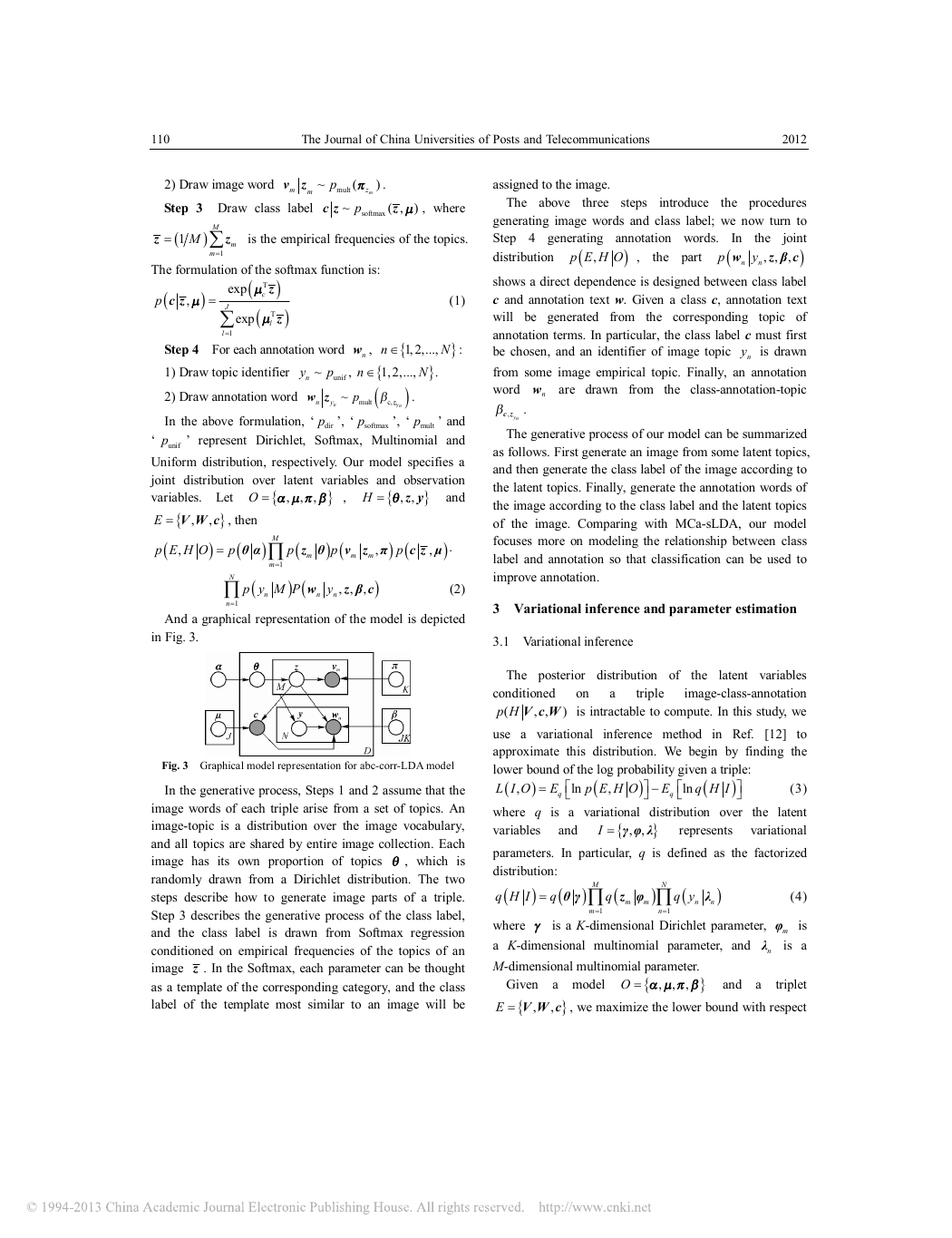

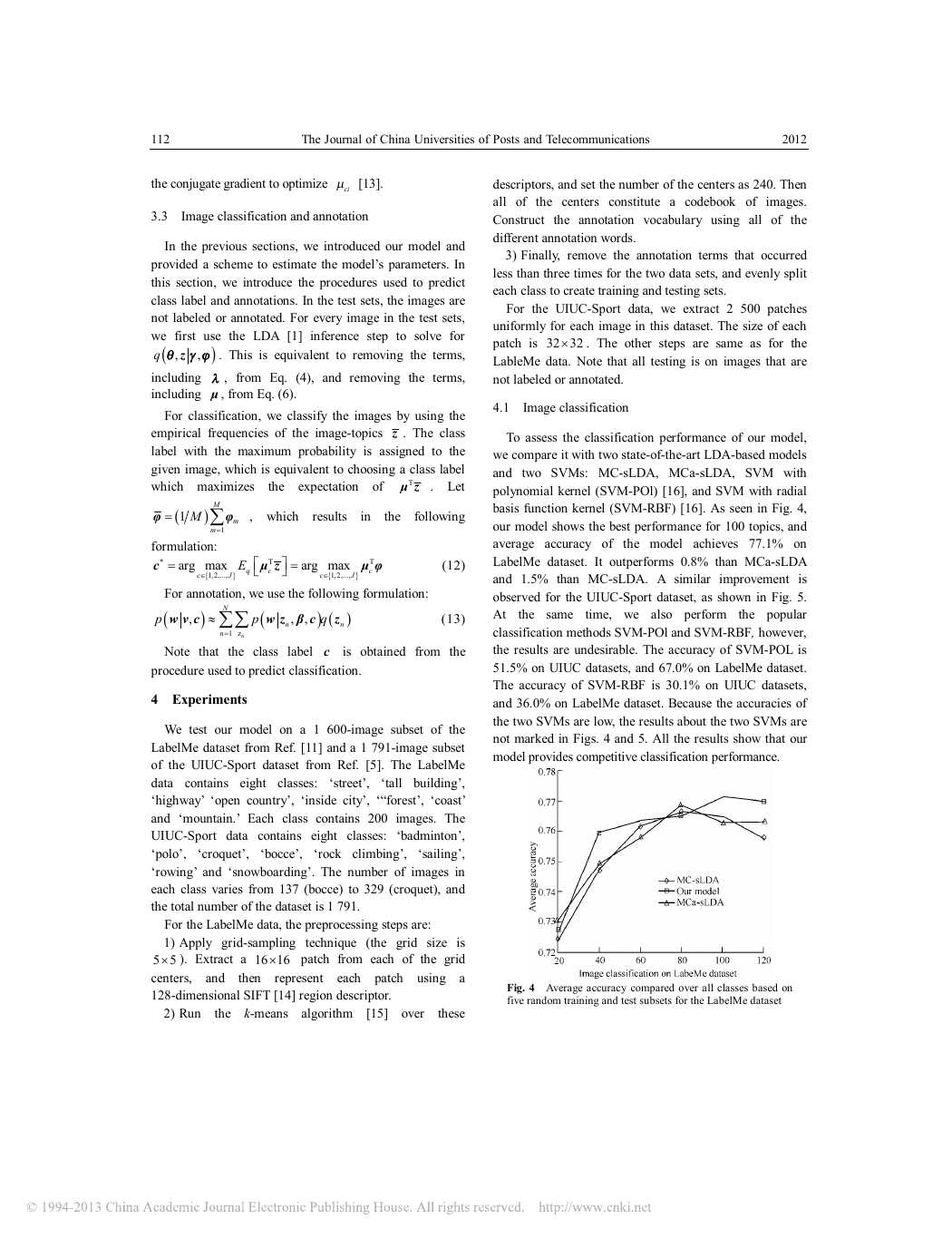
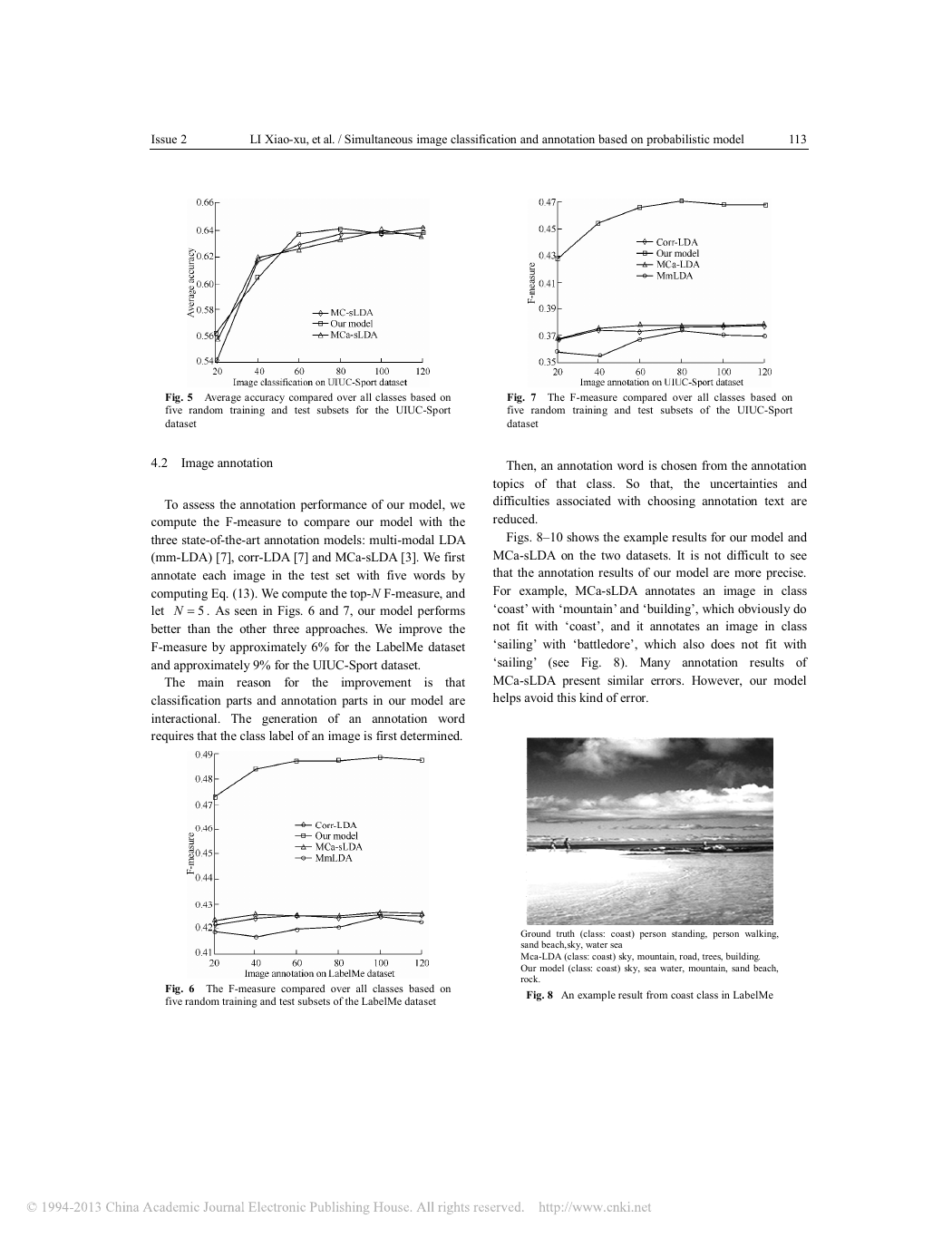









 2023年江西萍乡中考道德与法治真题及答案.doc
2023年江西萍乡中考道德与法治真题及答案.doc 2012年重庆南川中考生物真题及答案.doc
2012年重庆南川中考生物真题及答案.doc 2013年江西师范大学地理学综合及文艺理论基础考研真题.doc
2013年江西师范大学地理学综合及文艺理论基础考研真题.doc 2020年四川甘孜小升初语文真题及答案I卷.doc
2020年四川甘孜小升初语文真题及答案I卷.doc 2020年注册岩土工程师专业基础考试真题及答案.doc
2020年注册岩土工程师专业基础考试真题及答案.doc 2023-2024学年福建省厦门市九年级上学期数学月考试题及答案.doc
2023-2024学年福建省厦门市九年级上学期数学月考试题及答案.doc 2021-2022学年辽宁省沈阳市大东区九年级上学期语文期末试题及答案.doc
2021-2022学年辽宁省沈阳市大东区九年级上学期语文期末试题及答案.doc 2022-2023学年北京东城区初三第一学期物理期末试卷及答案.doc
2022-2023学年北京东城区初三第一学期物理期末试卷及答案.doc 2018上半年江西教师资格初中地理学科知识与教学能力真题及答案.doc
2018上半年江西教师资格初中地理学科知识与教学能力真题及答案.doc 2012年河北国家公务员申论考试真题及答案-省级.doc
2012年河北国家公务员申论考试真题及答案-省级.doc 2020-2021学年江苏省扬州市江都区邵樊片九年级上学期数学第一次质量检测试题及答案.doc
2020-2021学年江苏省扬州市江都区邵樊片九年级上学期数学第一次质量检测试题及答案.doc 2022下半年黑龙江教师资格证中学综合素质真题及答案.doc
2022下半年黑龙江教师资格证中学综合素质真题及答案.doc